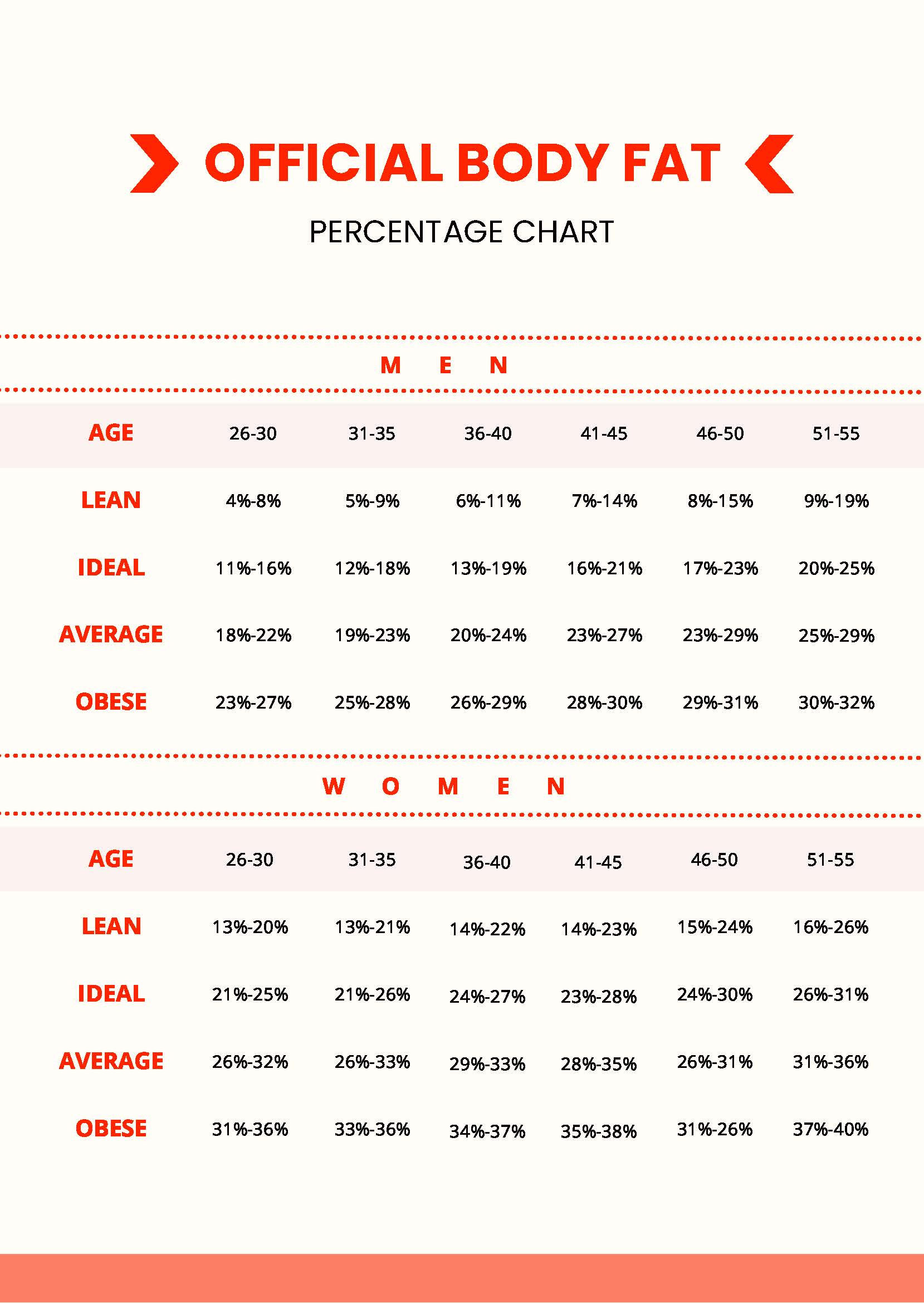Körperfett (BF) bezieht sich auf das Verhältnis von Fett ( Fetgewebe ) im Körper im Vergleich zum Gesamtgewicht. 1Während Körpermassenindex (BMI) wird oft verwendet, um Körperfett zu schätzen, es ist jedoch nicht immer eine genaue Methode.
Einige Forscher glauben, dass der Körperfettanteil einen zuverlässigeren Indikator für potenzielle gesundheitliche Komplikationen im Zusammenhang mit Übergewicht bietet, wie Herzkrankheiten und Typ-2-Diabetes
Dieser Artikel wird sich mit durchschnittlichen Körperfettanteilsdiagrammen in den Vereinigten Staaten nach Alter und Geschlecht beschäftigen sowie zeigen, wie man ihn berechnet.

Es gibt mehrere Methoden, um den Körperfettanteil zu messen. Du kannst ihn zu Hause messen oder mit der Hilfe eines Profis, wie einem Gesundheitsfachmann, physiotherapeutisch , oder Personal Trainer.
Methoden zur Schätzung des Körperfettanteils umfassen: 3
Durchschnittlich neigen Frauen dazu, höhere Körperfettprozentwerte als Männer zu haben, auch bei gleichem BMI. Dies ist wahrscheinlich auf Unterschiede in der Körperschaffenheit zurückzuführen, die den weiblichen Körper auf eine potenzielle Schwangerschaft vorbereiten.
Änderungen der Hormonspiegel (insbesondere Östrogen ) über den Lebenszyklus hinweg, besonders während der Pubertät und danach Menopause , verursachen bei Frauen eine unterschiedliche Stoffwechselaufnahme und ein einfacheres Fettabspeichern.
Die folgenden Daten zum durchschnittlichen Körperfettanteil von Männern und Frauen in den Vereinigten Staaten wurden im Rahmen der Nationalen Gesundheits- und Ernährungsumfrage gesammelt und vom Centers for Disease Control and Prevention (CDC) verteilt. 5
Wie vom CDC gemeldet, liegen die durchschnittlich geschätzten Körperfettanteile bei Männern und Frauen in den Vereinigten Staaten wie folgt vor

Der durchschnittliche Körperfettanteil in den Vereinigten Staaten beträgt insgesamt etwa 39,9 % für Frauen und 28,1 % für Männer, sodass Werte unter diesen Beträgen technisch gesehen „unterdurchschnittlich“ wären. Die meisten Menschen in den USA neigen jedoch dazu, höhere BF-Werte als empfohlen zu haben. 6
Laut dem American Council on Exercise (ACE) beträgt der normale Körperfettanteil für Frauen zwischen 25 % und 31 % und für Männer zwischen 18 % und 24 %. Ein BF unter 14 % bei Frauen oder 6 % bei Männern gilt möglicherweise als gefährlich niedrig und kann zu Gesundheitsrisiken führen. 7
In den Vereinigten Staaten würde ein überdurchschnittlicher Körperfettanteil ungefähr 40 % oder mehr bei Frauen oder 28 % bei Männern betragen. 6Studien deuten jedoch darauf hin, dass Männer mit einem Körperfettanteil von 25 % oder mehr sowie Frauen mit einem BF von 35 % oder höher möglicherweise ein erheblich höheres Risiko für gesundheitliche Probleme aufweisen könnten, wie Koronarer Herzkrankheit (CHD). Andere Forscher setzen die obere optimale Grenze für Frauen auf 32 %.
Laut CDC beträgt dies der durchschnittlich geschätzte Körperfettanteil in verschiedenen Altersgruppen:

Es gibt keinen einzigen allgemein akzeptierten optimalen Körperfettanteil. Stattdessen hängt der richtige Fettanteil für Sie von Ihren spezifischen Ernährungsgewohnheiten, Nährstoffbedarf, zugrundeliegenden Gesundheitszuständen und persönlichen Zielen ab.
Ein professioneller Athlet wird beispielsweise wahrscheinlich einen viel niedrigeren idealen Körperfettanteil haben als jemand mit einem durchschnittlichen Grad an körperlicher Aktivität.
Der American Council on Exercise hat folgende mögliche BF-Prozentbereiche für Männer auf verschiedenen Fitnessstufen erarbeitet: 7
Häufige Körperfettprozentsätze bei Frauen in verschiedenen Fitnessstufen sind wie folgt:
Wenn Sie Ihren Körperfettanteil erhöhen oder verringern möchten, arbeiten Sie mit einem Gesundheitsexperten zusammen, um einen Ernährungs- und Bewegungsplan zu entwickeln, der für Sie funktioniert. 7
Überschüssiges Bauchfett ist mit einem höheren Risiko vieler verschiedener Gesundheitsprobleme verbunden, einschließlich Herzkrankheiten, Diabetes und Schlaganfall. Forschungen deuten darauf hin, dass sich an mindestens 150 Minuten moderater bis hochintensiver aerober Bewegung pro Woche beteiligen kann die Taille signifikant verringern und das Risiko chronischer Gesundheitsprobleme senken. 9

Viele Forscher glauben, dass ein Körperfettanteil von 25 % oder mehr bei Männern oder 32 % bis 35 % oder mehr bei Frauen möglicherweise gefährlich hoch ist. Sie sollten jedoch einen Gesundheitsexperten konsultieren, um die richtigen Ziele für Ihren Körper zu setzen, basierend auf Ihrer Ernährung und Ihrer körperlichen Aktivität.
 Aktuelle Nachrichten
Aktuelle Nachrichten2024-12-16
2024-11-21
2024-10-17
2024-09-06
2024-01-24
2024-01-10